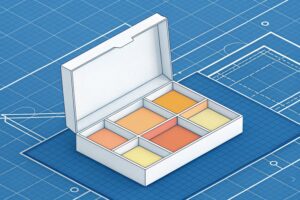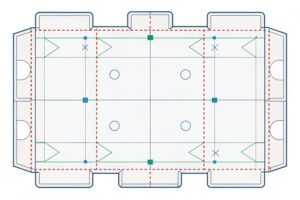Qu'est-ce qu'une palette PDQ?
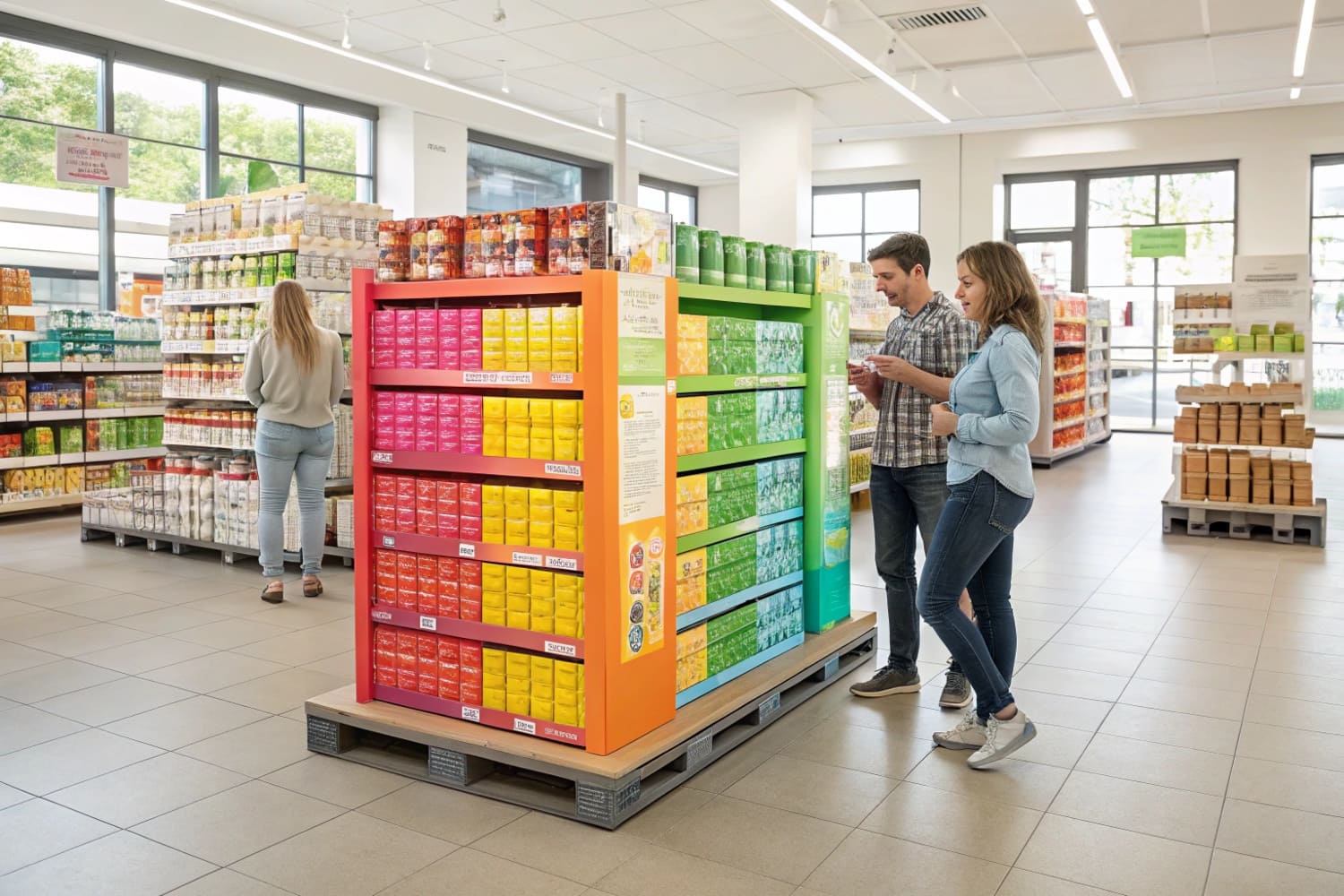
Les palettes PDQ sont souvent visibles dans les espaces de vente au détail, mais peuvent laisser beaucoup de questions sur leur objectif exact et leur conception. Avez-vous déjà remarqué ces écrans accrocheurs dans les supermarchés ou les magasins qui attirent tout de suite votre attention? Les palettes PDQ sont les héros méconnus du placement des produits, conçus pour rationaliser la visibilité et l'accessibilité du produit.
Les palettes PDQ sont des unités préalables et emballées conçues pour être placées sur le plancher de vente pour améliorer la visibilité et les ventes des produits. Leur conception permet une réapprovisionnement facile du produit et une configuration rapide.
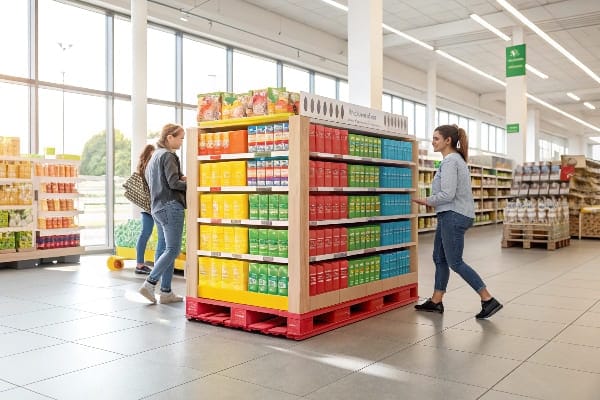
Dans le commerce de détail, la façon dont les produits sont affichés peuvent faire ou briser une vente. C'est pourquoi les palettes PDQ jouent un rôle si important en mettant les produits au premier plan d'une manière à la fois pratique et visuellement attrayante. Ces palettes sont généralement remplies d'unités de produits plus petites et prêtes à vendre, ce qui les rend pratiques pour les détaillants et pour les clients à parcourir. Le terme «PDQ» signifie «Jolith Darn Quick», un nom d'ajustement étant donné leur capacité à afficher et à réapprovisionner rapidement.
Qu'est-ce qu'un affichage de palette?
Les détaillants s'appuient depuis longtemps sur les écrans de palette comme un moyen efficace de présenter des produits en vrac. Êtes-vous déjà entré dans un magasin et avez-vous remarqué une énorme pile de produits disposés soigneusement sur une palette en bois ou en carton? Il s'agit d'un affichage de palettes, une partie essentielle de la stratégie de vente au détail. Mais pourquoi sont-ils si efficaces?
Un affichage de palette est un outil de marketing utilisé par les détaillants pour présenter des produits directement sur une palette, souvent dans des zones à fort trafic. Il est conçu pour attirer l'attention du client et encourager les achats immédiats.
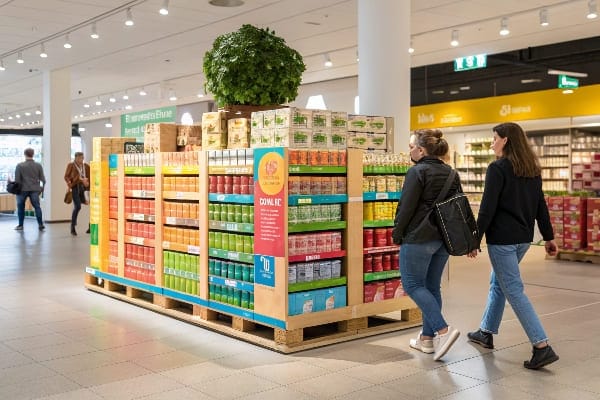
Les écrans de palette sont souvent utilisés pour leur haute visibilité 1 et la facilité d'accès. Ils sont particulièrement efficaces pour présenter des produits en vrac ou des articles qui doivent être réapprovisionnés fréquemment. Ces écrans aident les détaillants à gérer efficacement les stocks 2 tout en offrant aux clients une vue claire et organisée des produits disponibles. Qu'il s'agisse de collations, de boissons ou de produits de saison, un affichage de palettes bien placé peut entraîner une augmentation des ventes en rendant les produits plus visibles et accessibles.
Types d'écrans de palette
Il existe plusieurs types d'affichages de palettes, chacun servant une fonction et un objectif différents dans les espaces de vente au détail. L'objectif principal est toujours de maximiser la visibilité et de faciliter le réapprovisionnement.
- Affichages de palettes en bois 3 : Le type le plus courant, offrant une base robuste pour les grands affichages de produits. Ils sont parfaits pour les articles lourds ou volumineux.
- Affichages de palettes en carton 4 : Celles-ci sont légères et personnalisables, souvent utilisées pour des produits plus petits et plus légers. Ils sont faciles à déplacer et à installer.
- Affichages de palettes en plastique 5 : Celles-ci sont durables et résistantes à l'humidité, idéales pour les articles qui ont besoin d'une protection supplémentaire pendant l'affichage.
Les détaillants choisissent le type d'affichage des palettes en fonction de la nature des produits et de leurs besoins d'affichage. Les affichages en carton, par exemple, sont souvent choisis pour leur rentabilité et leur facilité de personnalisation.
Quels sont les codes sur les palettes?
Si vous avez déjà remarqué des codes ou des étiquettes sur des écrans de palette dans les magasins, vous vous êtes peut-être demandé ce qu'ils signifient. Ces codes sont essentiels dans le monde de la vente au détail et de la logistique, aidant les entreprises à suivre et à gérer les produits. Ils peuvent être utilisés pour fournir des informations sur le produit, le lot ou même la date à laquelle il a été produit.
Les codes sur les palettes, tels que UPC ou SKU, sont utilisés pour suivre l'inventaire, gérer les expéditions et assurer une rotation appropriée des stocks. Ces codes sont essentiels pour la logistique efficace et la gestion de la chaîne d'approvisionnement.
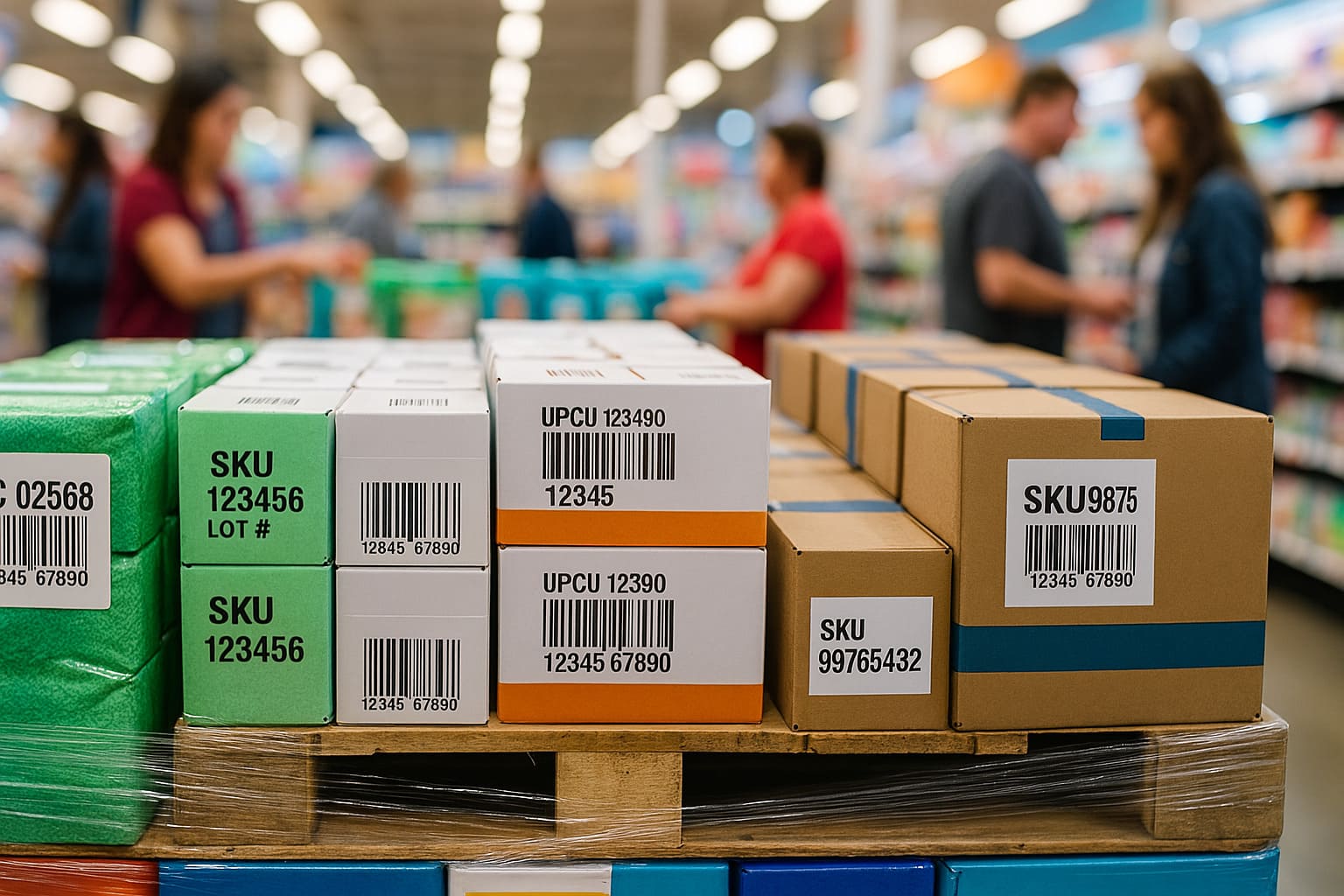
Chaque palette possède généralement un identifiant unique 6 qui aide les détaillants et le personnel de l'entrepôt à identifier rapidement le contenu. Par exemple, un Code 7 sur une palette aide le magasin à scanner la palette dans son système d'inventaire 8 , ce qui facilite le suivi des besoins de vente et de réapprovisionnement. Ces codes jouent un rôle crucial pour garantir que les détaillants sont toujours préparés à la demande de produits et peuvent gérer plus efficacement les actions.
Types de codes sur les palettes
Il existe plusieurs types de codes que vous pourriez rencontrer sur des palettes:
- UPC (Code produit universel) 9 : Le code-barres standard utilisé pour identifier les produits individuels.
- SKU (Stock Keeping Unit) 10 : Un identifiant unique attribué aux produits pour la gestion des stocks.
- Lot numéro 11 : un code qui aide à identifier un lot de produits spécifique, utile pour le suivi des dates d'expiration ou des rappels.
En utilisant ces codes, les détaillants peuvent rationaliser leurs opérations, réduire les erreurs humaines et assurer une expérience plus fluide pour les employés et les clients.
Quels sont les trois types de palettes?
Les palettes se présentent sous différentes formes et tailles, chacune adaptée à des tâches spécifiques dans la chaîne d'approvisionnement et les environnements de vente au détail. Bien que les palettes PDQ ne soient qu'une variation, il est important de comprendre les principaux types de palettes couramment utilisées.
Les trois types de palettes les plus courants sont en bois, en plastique et en métal. Chaque type présente des avantages spécifiques en fonction du matériau, du produit et de l'utilisation.
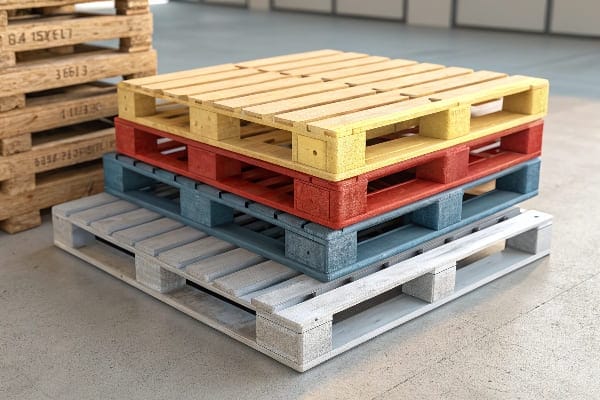
Chaque type de palette est adapté à une application différente. Les palettes en bois 12 sont souvent les plus abordables et les plus polyvalentes, ce qui en fait un choix populaire pour expédier et stocker de grands produits lourds. Les palettes en plastique 13 sont plus légères et résistantes aux facteurs environnementaux comme l'humidité, ce qui les rend idéales pour les industries qui nécessitent des options hygiéniques plus durables. Les palettes métalliques 14 sont les plus difficiles, souvent utilisées dans les industries, avec des exigences de poids ou de durabilité extrêmes.
Comparaison des trois types de palettes
| Type de palette | Coût | Durabilité | Poids | Meilleure utilisation |
|---|---|---|---|---|
| En bois | Faible | Modéré | Lourd | Produits en vrac, marchandises d'expédition |
| Plastique | Modéré | Haut | Léger | Produits hygiéniques et sensibles |
| Métal | Haut | Très haut | Lourd | Conditions extrêmes, biens industriels |
Bien que le coût varie pour chaque type, le choix de la bonne palette peut faire une grande différence en termes de sécurité des produits, d'efficacité du transport 15 et de rentabilité 16 pour les détaillants et les fournisseurs.
Quelles sont les exigences de l'affichage des palettes chez Costco?
Costco, connu pour ses ventes en vrac et ses achats de style entrepôt, a des exigences spécifiques en ce qui concerne les écrans de palette. Les détaillants qui souhaitent placer leurs produits sur les planchers de Costco doivent respecter certaines normes pour s'assurer que leurs écrans répondent aux directives de l'entreprise.
Les exigences d'affichage des palettes de Costco incluent des règles spécifiques de taille, d'étiquetage et de placement. Ces normes garantissent la sécurité, la visibilité des produits et la cohérence dans les magasins.
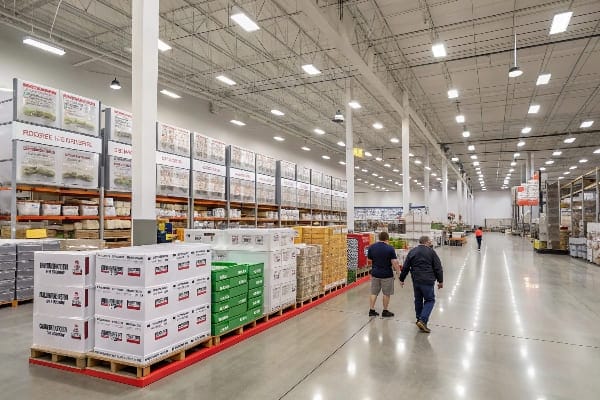
Pour commencer, Costco exige que les palettes 17 soient de la bonne taille pour l'espace qu'ils occupent. Leurs espaces de plancher sont organisés de manière spécifique pour maximiser la visibilité du produit et assurer un flux de trafic 18 . Les affichages de produits doivent être clairement étiquetés avec les codes corrects et les produits doivent être disposés proprement pour un accès facile.
Exigences clés pour les écrans de palette Costco
- Taille et dimensions 19 : La palette doit s'adapter dans la zone désignée sans entraver les passerelles ou autres écrans.
- Étiquetage des produits 20 : Chaque produit doit être clairement étiqueté avec des codes à barres ou d'autres identifiants pour faciliter la numérisation et la gestion des stocks.
- Nettoyer et organisé 21 : Les produits doivent être empilés soigneusement et en toute sécurité pour éviter les accidents ou les dommages pendant l'interaction du client.
Ces exigences garantissent que les produits sur les écrans de palette sont à la fois visibles et faciles à accéder aux clients, ce qui affecte directement les ventes.
Conclusion
Comprendre le rôle des palettes PDQ et des écrans de palettes peut améliorer considérablement la visibilité des produits et les stratégies de vente. En adhérant à des directives spécifiques d'affichage de palettes, les détaillants peuvent s'assurer qu'ils répondent aux normes de l'industrie tout en offrant aux clients une expérience de magasinage attrayante et organisée.
Découvrez des informations sur l'importance d'une grande visibilité dans le commerce de détail et de ses effets sur le comportement d'achat des clients. ↩
Découvrez des stratégies de gestion des bourses efficaces qui peuvent optimiser les stocks et améliorer les performances des ventes. ↩
Explorez les avantages des étalages de palettes en bois pour comprendre leur rôle dans l'amélioration de la visibilité et de la stabilité des produits dans les environnements de vente au détail. ↩
Découvrez comment les écrans de palettes en carton peuvent augmenter les ventes grâce à leurs fonctionnalités légères et personnalisables, ce qui les rend idéales pour divers produits. ↩
Découvrez la durabilité et la résistance à l'humidité des étalages de palettes en plastique, ce qui les rend parfaits pour protéger les produits dans les milieux de vente au détail. ↩
L'exploration du concept d'identifiants uniques peut améliorer votre connaissance des systèmes d'inventaire et améliorer les pratiques de gestion des bourses. ↩
Comprendre les codes UPC est essentiel pour une gestion efficace des stocks et le suivi des ventes, ce qui en fait une ressource précieuse pour les détaillants. ↩
Apprendre les systèmes d'inventaire peut aider les détaillants à optimiser leurs opérations et à mieux répondre à la demande de produits. ↩
La compréhension des codes UPC peut améliorer votre connaissance de l'identification des produits et de la gestion des stocks dans le commerce de détail. ↩
Explorer SKU vous aidera à comprendre comment les entreprises gèrent efficacement les stocks et améliorent l'efficacité opérationnelle. ↩
Apprendre les chiffres de lot est crucial pour comprendre la sécurité des produits, les rappels et le suivi de l'expiration dans les chaînes d'approvisionnement. ↩
Explorez les avantages des palettes en bois, y compris la rentabilité et la polyvalence pour les besoins d'expédition et de stockage. ↩
Découvrez pourquoi les palettes en plastique sont privilégiées pour leurs propriétés légères et résistantes à l'humidité, idéales pour les applications hygiéniques. ↩
Découvrez l'extrême durabilité des palettes métalliques et leurs applications dans les industries lourdes. ↩
Découvrez les facteurs clés qui améliorent l'efficacité du transport, y compris la sélection des palettes. Ce lien offre des conseils complets. ↩
Découvrez comment la sélection de la bonne palette peut réduire les coûts et améliorer l'efficacité de l'expédition. Cette ressource fournit des informations précieuses. ↩
La compréhension des tailles de palettes standard peut aider à optimiser le placement des produits et la visibilité dans les environnements de vente au détail. ↩
Explorez les stratégies pour améliorer le mouvement et l'expérience des clients dans les espaces de vente au détail, en assurant un parcours de magasinage en douceur. ↩
Connaître la bonne taille et les bonnes dimensions pour les écrans peuvent optimiser l'utilisation de l'espace et améliorer la visibilité des produits, cruciale pour la conduite des ventes. ↩
Comprendre l'étiquetage efficace des produits peut améliorer la gestion des stocks et améliorer l'expérience client, ce qui entraîne une augmentation des ventes. ↩
Un écran propre et organisé attire non seulement les clients, mais assure également la sécurité et l'efficacité de l'accès aux produits, ce qui augmente le potentiel de vente. ↩


